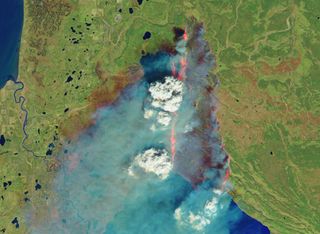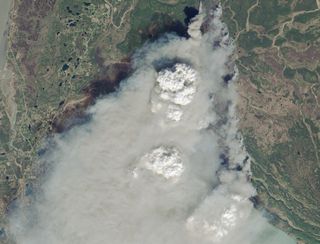Brilliant Colors of Alaska Wildfire Seen from Space

Alaska's Funny River fire cuts across the landscape like a neon wound in a new satellite image of the state's Kenai Peninsula.
The fire began on May 19, likely as a result of an improperly extinguished campfire, state officials have said. As of yesterday (May 22), the fire had spread over 44,423 acres (180 square kilometers) and was 5 percent contained, according to the state's interagency incident management team.
The fire is within about 3 miles (4.8 km) of several subdivisions, and is being battled both by firefighters on the ground, by smokejumpers and by water-scooping aircraft. Air quality advisories have been issued for southcentral Alaska because of the smoke from the fire. So far, no homes have been consumed by the fire, and there are currently no evacuation orders in place.
Satellite imagery, however, makes the extent of the burn clear. The Landsat 8 satellite captured the Funny River fire in natural color on May 21, as well as in infrared light. The latter view reveals the layers of the fire in false color: Orange for flames, reddish-brown for burnt Earth, and light blue for smoke. Tustumena Lake is at the bottom of the image in royal blue, and Cook Inlet is to the left.

The mushroom-like structures within the smoke are pyrocumulonimbus clouds, according to NASA's Earth Observatory. These clouds are the fire's own weather: They form from superheated air rising over the fire. Pyrocumulonimbus clouds sometimes produce light precipitation, and sometimes are associated with lightning or hail.
According to a 2010 paper in the Bulletin of the American Meteorological Society, pyrocumulonimbus clouds are capable of pushing particles from smoke into the stratosphere, a phenomenon once blamed on volcanic eruptions.
In the natural-color image, the pyrocumulonimbus clouds rise above a carpet of smoke. Hot, dry weather has stoked forest fires in Alaska as well as Siberia this spring.
Sign up for the Live Science daily newsletter now
Get the world’s most fascinating discoveries delivered straight to your inbox.
Editor's Note: If you have an amazing Earth or general science photo you'd like to share for a possible story or image gallery, please contact managing editor Jeanna Bryner at LSphotos@livescience.com.
Follow Stephanie Pappas on Twitter and Google+. Follow us @livescience, Facebook& Google+. Original article on Live Science.

Stephanie Pappas is a contributing writer for Live Science, covering topics ranging from geoscience to archaeology to the human brain and behavior. She was previously a senior writer for Live Science but is now a freelancer based in Denver, Colorado, and regularly contributes to Scientific American and The Monitor, the monthly magazine of the American Psychological Association. Stephanie received a bachelor's degree in psychology from the University of South Carolina and a graduate certificate in science communication from the University of California, Santa Cruz.
